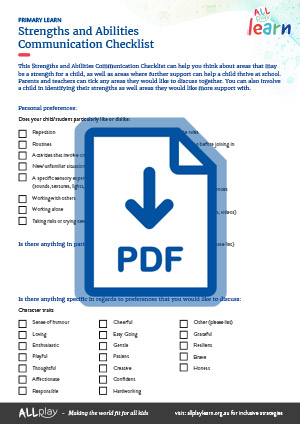Get more information. Talk with the child and their parents to find out the child’s unique strengths and abilities, any areas they need more support with, and the best methods of communication.
Build a relationship with other professionals involved in supporting the child. Working together can lead to a shared understanding of how best to support the child and use strategies that are the same in the primary school setting and other settings such as home.
Consider handwriting activities. For children who experience challenges with fine motor skills, consider spending short periods of time, multiple times a week, on handwriting. An activity that might help is getting children to copy a correct version of each letter of the alphabet. Arrows around each letter, indicating the direction of each stroke, and the order of each stroke to write a letter, may be helpful.
Help children self-reflect on handwriting. Some children who experience challenges with fine motor skills may benefit from activities that encourage them to self-reflect on their handwriting. For example, help children understand the shape of letters (e.g. where does the letter ‘a’ start and finish). Ask them to practise writing the same letter, at the same size, repeatedly (e.g. the letter ‘a’ eight times). Then, ask children to choose which letter they wrote best and draw a circle around it. You can also ask them to use an arrow to show which part of the letter they need to improve and practise that part.
Plan ahead. Before beginning an activity, check that any equipment or adjustments that might encourage full participation of the child are available.
Focus on what students can do. Provide encouragement, especially of children’s strengths and achievements. Your attitude can make a difference in student’s participation and learning.
Change the activity to support the student. If a student is struggling with an activity consider how it can be tailored to their strengths and abilities. For example, if a writing task is difficult for a student to complete, encourage them to use an alternate way to demonstrate their skill such as verbally providing an answer.
Remove classroom clutter. De-cluttering the environment can allow for easy movement for all students with reduced gross motor skills.
Use music to get children moving. Music can improve movement ability in children. Try “moving to the beat” of an instrument in a safe environment, or letting students adapt how they play an instrument to better fit with their abilities
Combine movement with music. Consider activities where students are asked to combine fine motor movements to the rhythm of a song or rhyme. For example, choose a song or rhyme, and ask children to rest their hands on their knees, one palm facing up and one down, while sitting on a chair. To the rhythm, ask them to raise their hands, rotate their hands so palms face the opposite way, and lower them to their knees. Repeat this for the whole song or rhyme.








